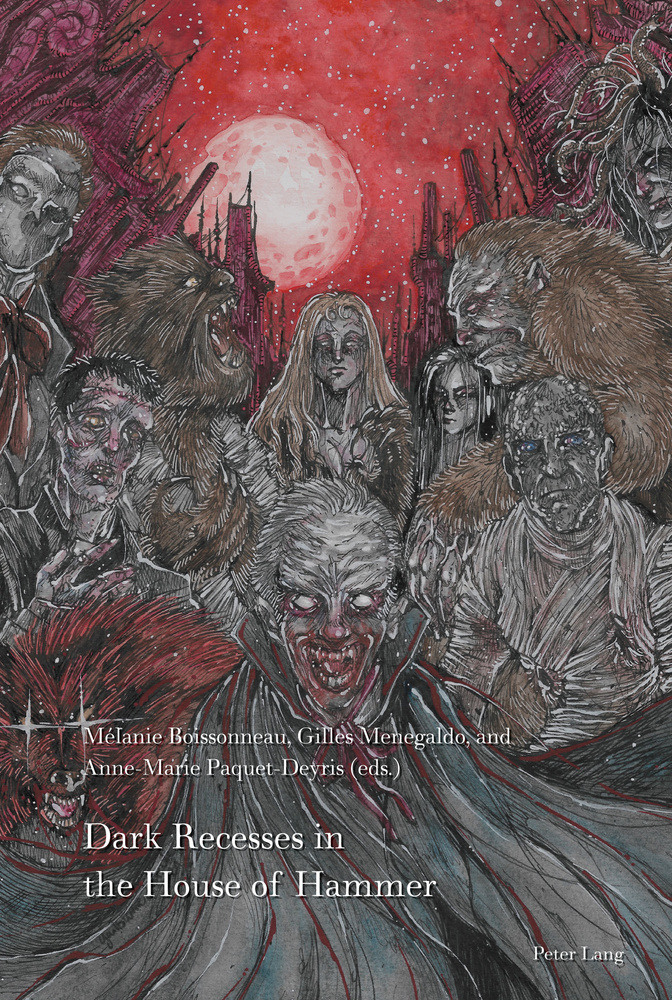Version française / Publications
- Libellé inconnu,
Dark Recesses in the House of Hammer
Mélanie Boissonneau, Gilles Menegaldo & Anne-Marie Paquet-Deyris (eds.)
Publié le 7 janvier 2022 – Mis à jour le 7 janvier 2022
Date: 2022. Editeur : Peter Lang. ISBN : 978-1-4331-8658-5 (Hardback) / 978-1-4331-8659-2 (eBook PDF).

Vingt ans après les films d'horreur Universal, le studio Hammer a redonné vie aux grandes figures mythiques inspirées de la littérature britannique ainsi que du folklore français et européen (Dracula, Frankenstein, le Loup-garou, le Fantôme de l'Opéra, etc.) Il invente de nouvelles incarnations ancrées dans un contexte historique précis et revisitées en fonction de l'évolution de la société britannique. Ce studio indépendant constitue une étape notable dans l'histoire du genre entre l'horreur gothique des années 1930 et les productions plus radicales des années 1970, qui ont finalement contribué à sa disparition. En se concentrant sur l'équilibre particulier entre l'inventivité et le classicisme du studio, ce volume explore principalement les productions moins connues, examinant également ses contradictions, ses paradoxes et ses limites.
L'ouvrage pose la question de la modernité paradoxale de films novateurs à divers égards (thèmes, modes de représentation défiant la censure, esthétique), mais qui tentent aussi de ressusciter une tradition moribonde, offrant le plus souvent un discours étonnamment conservateur malgré leurs efforts pour se conformer aux attentes des nouveaux publics. Les films nés de la récente renaissance du studio font toujours référence à cet âge d'or révolu du film d'horreur. On peut se demander si le studio Hammer n'était qu'une simple usine produisant des films d'horreur conventionnels, aujourd'hui enterrés dans la poussière d'un donjon gothique, ou un véritable laboratoire de l'horreur cinématographique moderne dont la gloire passée inspire encore les cinéastes contemporains. Ce volume apportera quelques réponses et soulèvera un certain nombre de questions.
L'ouvrage pose la question de la modernité paradoxale de films novateurs à divers égards (thèmes, modes de représentation défiant la censure, esthétique), mais qui tentent aussi de ressusciter une tradition moribonde, offrant le plus souvent un discours étonnamment conservateur malgré leurs efforts pour se conformer aux attentes des nouveaux publics. Les films nés de la récente renaissance du studio font toujours référence à cet âge d'or révolu du film d'horreur. On peut se demander si le studio Hammer n'était qu'une simple usine produisant des films d'horreur conventionnels, aujourd'hui enterrés dans la poussière d'un donjon gothique, ou un véritable laboratoire de l'horreur cinématographique moderne dont la gloire passée inspire encore les cinéastes contemporains. Ce volume apportera quelques réponses et soulèvera un certain nombre de questions.
- Sommaire
-
- Preface: The Need for Hammer Films (Antonio Sanna)
- Introduction: Dark Recesses in the House of Hammer (Mélanie Boissonneau, Gilles Menegaldo, Anne-Marie Paquet-Deyris)
- Part I Iconic Monsters and Actors
Intermediality as a Way to Debunk Tradition: New Perspectives on Terence Fisher’s The Curse of Frankenstein (1957) (Isabelle Labrouillère)
The Phantom of the Opera Goes Victorian (Dorota Babilas)
Acting Hammer Style: About Peter Cushing and Christopher Lee (Hélène Valmary)
- Part II Genre and Gender
Hammer Motel: Twisted Nerves and Twisted Plots in the Post-Psycho British Psycho-Thriller (Jean-François Baillon)
Hammer Science-Fiction Horror and the Decline of the British Male Hero: The Quatermass Trilogy (Gaïd Girard)
The Political Complications of Revamping the Horror Canon: The Vampire Lovers (Baker, 1970), Dr. Jekyll & Sister Hyde (Baker, 1971), Dracula A.D. 1972 (Gibson, 1972) and The Satanic Rites of Dracula (Gibson, 1973) (David Roche)
Why Does Sherlock Holmes Capture the Black Rook of Dr. Mortimer in Terence Fisher’s The Hound of the Baskervilles (1959)? (Jean-Pierre Naugrette)
- Part III Aesthetics of Horror
The Vampire Figure: Recurring Principles in Hammer’s Symphonic Film Music until Twilight: New Moon (Cécile Carayol)
Terence Fisher with a Lake Scenery (Jean-Michel Durafour)
Jack Asher (1916–1991) and the Creation of an Original ‘Eastman Color’ Hammer: Between Hollywood Color Tropes and Aesthetic Innovation (Raphaëlle Costa de Beauregard)
The Sonic Realm in The Quatermass Experiment: Medium and Genre and Sound (Robynn J. Stilwell)
Hammer’s Children, Between Visuality and Aurality (Philippe Met)
- Part IV Post-Colonial Gothic and Imperial Politics
Beauty is the Beast: Horror According to John Gilling (Christian Chelebourg)
Unmasking the Other: Danger and Difference in Hammer’s Colonial Horrors (Rehan Hyder)
Postcolonial Anxieties in Hammer’s Dracula and The Curse of Frankenstein (Vicky Walden)
Epistemology and Power Politics in The Abominable Snowmen (1957) and Lesser-Known Hammer Gothics (Jean-Marie Lecomte)
- Part V Mutations, Unmade Projects and Resurrection
Hammer Hybrids, Genre Mutation and 1970s Horror Cinema (Ian Conrich)
Reigniting the Blaze: Hammer’s Unmade Remake of The Day the Earth Caught Fire (Matt Jones)
Mapping Cult Topographies and Transgressive Space: Hammer’s Legacy in The Rocky Horror Picture Show (Marisa C. Hayes)
A New Old Hammer? The Woman in Black (James Watkins, 2012) (Sophie Mantrant)
- General Bibliography
- Index
- Preface: The Need for Hammer Films (Antonio Sanna)
Mis à jour le 07 janvier 2022












